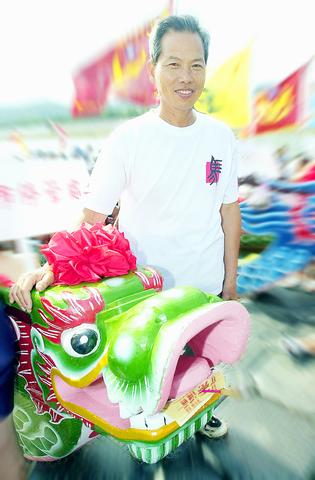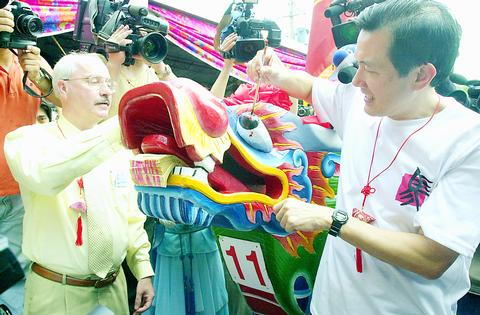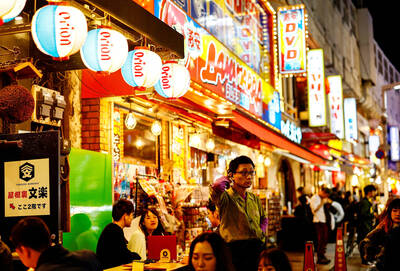On Friday afternoon, Taipei had its first heavy rainfall in months, disrupting the dragon boat training session of the Sanjiaotu (三角渡) community. The elderly men who made up the gathering were not particularly upset, for they would only be paddling in a exhibition race that will form part of the Taipei City Dragon Boat Race to be held on the Keelung River from June 16 to June 18.
Controlling the rudder during the race will be Liu Ching-cheng (劉清正), one of the last professional builders of dragon boats in Taiwan. With the training session called off, Liu settled down under the eves of the Tiente Temple (天德宮) to talk about the dying art that he continues to practice. Around the temple are some printed materials and photographs declaring him Taiwan's last master boat builder. Liu, a vigorous 62-year-old who could pass for 40, is clearly tickled by the attention, if a little bewildered by it.
Building boats is what he has done all his life and he has continued to practice the old methods as the world changed about him. He is the fourth-generation of his family to build boats on the banks of the Keelung River. He built every one of the sampans moored off the little dock across from the temple.

PHOTO: CHIANG YING-YING, TAIPEI TIMES
"And pretty much all the wooden boats that still work the mouth of the Tamsui River were built by me," he says with a peculiar blend of humility and pride.
"Ten years ago, when the fishermen started to shift to fiberglass, they wanted me to carry on making boats for them," he said. "They said the shape I made was more attractive. But I was too old by then, and working with fiberglass can be bad for the health, so I kept on with what I knew, working with wood."
In the last few weeks, Liu has traveled extensively to check over boats preparing for many regional and national races that are to be held over the Dragon Boat Festival weekend. For someone who has built boats for over 40 years, and who built many of the boats that will race in the major Taipei City and Taipei County races, it is not difficult work. And although he now uses a range of materials that extend to epoxy polymers, he is noticeably glad to show off a more traditional product, digging it out from the fridge at the back of the temple.

PHOTO: CHIANG YING-YING, TAIPEI TIMES
"This stuff has been used for thousands of years," he said, pointing to a ball of gray clay-like paste in a plastic wrap. "It is a mixture of quick lime and the oil from a scholar tree. Only a few people make it now." Another traditional material used to fix leaks in planking, the fiber from cypress tress, is now virtually never found. "We break up rope for stuffing, and seal it with epoxy," he said.
He shows little regret, but his enjoyment of the fragrant oil mixture was something that underlay his acceptance of the modern world. The boats themselves are built of cypress and cedar, local hardwoods which, after over a century of indiscriminate logging, now fall under a government ban. "Most of the wood I use is decades old," Liu said, suggesting a metaphor for his craft that draws on diminishing stores of knowledge and participation.
Liu recalls the days of his youth when he raced dragon boats as well as built them. "In those days, when I was in my teens, the riverbanks would be lined with people, and the river littered with watercraft, with people wanting a better look at the race."
Liu has lived through other changes in boat racing. "Back in 1988, the government here presented people in the US with two dragon boats. In those days, most freight containers were 40m long, so we built boats with nine sets of oars that would fit just right.
After that, it became the fashion for men's boats to have nine sets. [Previously the norm had been 11 sets.] It also made it easier to get teams together," Liu said.
The competition boats racing in this year's event will have nine sets of oars for men and seven sets of oars for women. It is amusing to think that the configuration of nine oars for the most Chinese of boat races was set by the size of freight containers in the 1980s.
In 2000, two of Liu's dragon boats appeared in the International Festival of Sailors and the Sea held in Brest, France. Both had been made by Liu, and in a display competition, Liu also was at the tiller. Liu's boats have been made gifts of state by Taiwan's government and can now be found in Japan, the US, South Africa, Germany and Finland.
While Liu is now part of Taiwan's presence abroad, he continues to make his boats out of the rather unexceptional workshop behind the river dikes along the Keelung River.
And he works in a way that recalls a past time.
"I have no diagrams," he said. "All the blueprints are in my head. I just need to be told how many pairs of oars are required, and I just work it out from there."
With around 102 teams participating in the Taipei City event alone, the dragon boat race still has considerable pull. But for Liu, it is a long way off from the heyday of racing.
Conflict between Taipei City and Taipei County has also produced politics that are likely to detract from the two major events on the Tachia section of the Keelung River and at Pitan on the Hsintien River. "People think about politics these days, and not about the race," Liu said.

On April 26, The Lancet published a letter from two doctors at Taichung-based China Medical University Hospital (CMUH) warning that “Taiwan’s Health Care System is on the Brink of Collapse.” The authors said that “Years of policy inaction and mismanagement of resources have led to the National Health Insurance system operating under unsustainable conditions.” The pushback was immediate. Errors in the paper were quickly identified and publicized, to discredit the authors (the hospital apologized). CNA reported that CMUH said the letter described Taiwan in 2021 as having 62 nurses per 10,000 people, when the correct number was 78 nurses per 10,000

May 5 to May 11 What started out as friction between Taiwanese students at Taichung First High School and a Japanese head cook escalated dramatically over the first two weeks of May 1927. It began on April 30 when the cook’s wife knew that lotus starch used in that night’s dinner had rat feces in it, but failed to inform staff until the meal was already prepared. The students believed that her silence was intentional, and filed a complaint. The school’s Japanese administrators sided with the cook’s family, dismissing the students as troublemakers and clamping down on their freedoms — with

As Donald Trump’s executive order in March led to the shuttering of Voice of America (VOA) — the global broadcaster whose roots date back to the fight against Nazi propaganda — he quickly attracted support from figures not used to aligning themselves with any US administration. Trump had ordered the US Agency for Global Media, the federal agency that funds VOA and other groups promoting independent journalism overseas, to be “eliminated to the maximum extent consistent with applicable law.” The decision suddenly halted programming in 49 languages to more than 425 million people. In Moscow, Margarita Simonyan, the hardline editor-in-chief of the

Six weeks before I embarked on a research mission in Kyoto, I was sitting alone at a bar counter in Melbourne. Next to me, a woman was bragging loudly to a friend: She, too, was heading to Kyoto, I quickly discerned. Except her trip was in four months. And she’d just pulled an all-nighter booking restaurant reservations. As I snooped on the conversation, I broke out in a sweat, panicking because I’d yet to secure a single table. Then I remembered: Eating well in Japan is absolutely not something to lose sleep over. It’s true that the best-known institutions book up faster